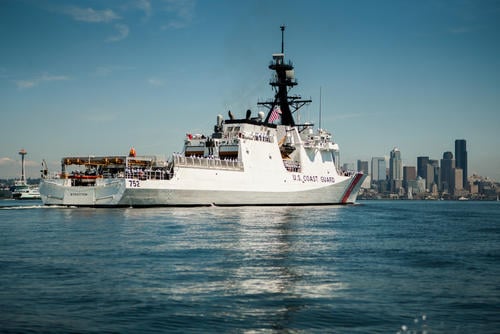
On a warm July day in 2014, U.S. Coast Guard deck hands took in the mooring lines at 0930 on board USCGC Stratton, one of the Service’s newest Legend-class national security cutters.
Stratton slowly drifted away from the San Diego pier while a show-stopping three short blasts sounded from the ship’s whistle, alerting nearby maritime traffic that the 418-foot steel vessel was backing out. The engines shifted, increasing speed ahead. Stratton was outbound for sea.
Approaching the dark waters of the Pacific Ocean, Coastguardsmen near the bow prepared the anchor for release, part of a planned drill to demonstrate their proficiency for on-board evaluators conducting an 18-month checkup. A couple decks above and behind, Capt. Andrew Sugimoto, the commanding officer, sat inside the bridge on an elevated, deeply cushioned “Captain’s” chair bolted to the deck. Out of habit, he mentally noted the fathometer, reading ample depth below the ship’s hull. Sugimoto, 47, with over 11 years at sea, commanded two previous Coast Guard cutters and was executive officer of two more. Having served on active duty for more than 25 years, he was accustomed to expecting the unexpected and wise about the ordinary becoming extraordinary. On this morning, neither Sugimoto nor any one of the 131 crewmembers suspected they would soon divert to stop drug smugglers off Mexico.
Suddenly, everything changed with a radio call from the Coast Guard command center in Alameda, Calif. Their mission surged from rehearsal to performance. “We hadn’t even passed the San Diego sea buoy when we got a call from the 11th Coast Guard District saying that a C-130 aircraft was overhead and spotted what appeared to be two suspicious vessels 160 miles south of San Diego,” Capt. Sugimoto said. “They asked, ‘Could we divert and investigate?’” By 1000 hours, Stratton was speeding to apprehend the smugglers before nightfall.
Out with the Old, In with the New
Stratton is one of eight planned national security cutters. This new class of ships replaces the 378-foot high endurance cutters built in the 1960s. The largest and most technologically advanced ships, they are the flagships of the Coast Guard’s approximately $1 billion annual investment in the next generation of ships, aircraft and command and control (C2) systems. This program, according to the Congressional Research Service, calls for procuring eight national security cutters estimated to cost $5.504 billion, or about $688 million in production costs per vessel. Stratton, along with her two sister ships, Bertholf and Waesche, are based in Alameda, Calif. The first East Coast cutter, Hamilton, based in Charleston, S.C. was commissioned on 6 December 2014.
These frigate sized vessels play a vital role addressing emerging and advanced threats to our national security, securing our borders and safeguarding commerce. The U.S. Coast Guard is further positioned to protect America’s maritime sovereignty by preventing, detecting and defeating threats as far from our shores as possible. Unlike ever before, this new fleet provides high-end capabilities and sophisticated technology enhancing the U.S. Coast Guard’s efforts in the Western Hemisphere. This resource is in great demand particularly for stopping offshore drug, contraband, and human smuggling by transnational criminal organizations operating in the southern approaches to the United States.
Setting the Trap
Captain Sugimoto described the events after Stratton got under way from the San Diego last summer. Leaving America’s coastline more than 100 miles behind, Stratton’s bridge watch focused ahead on closing the gap between the ship and the suspects’ position off Mexico. A deck below, inside the state-of-the-art surveillance and reconnaissance equipped Command Information Center a six-person team of specialists framed the picture for Capt. Sugimoto and the 11th District Command Center, hundreds of miles away in Alameda. The men and women used a command and control system, which includes surface search radar, air search radar, and an electronic warfare suite designed to detect enemy radars. Sugimoto says those tools offer a great way of picking up tracks and determining distances, and enhancing awareness of what’s going on in the waters surrounding the ship. The forward-looking infrared camera system looks out 7 or 8 miles, day or night, detecting heat from a source.
“I’m like a kid in a candy store, without a doubt,” says Sugimoto of his first year of his two-year tour. To support the “art of surprise” plan, he readied the ship’s flight deck in case he wanted it and pulled in the San Diego-based Coast Guard Cutter Petrel, an 87-foot patrol boat. The Stratton’s distinctive communication suite linked the cutter’s small boats with the aircraft and Petrel. Stratton’s team could also dial into any of the radio circuits and listen to breaking news, adjusting plans accordingly. All units were under Stratton’s tactical control.
Combining all the sensors’ input with the ship’s state-of-the-art communications system allows the team to have an accurate operational picture beyond what it can see from the bridge and radar views. This detail is displayed on a big screen and on monitors assisting Coastguardsmen like Lt. Cmdr. Morgan Holden, 35, who is Stratton’s tactical action officer. Holden is ultimately responsible for locating the suspects. “It’s hard to find these guys on radar,” said Holden. “From 30 miles away I need to see what’s going on. The different angles provided by the Petrel, the aircraft, and our own information gives me the whole picture so I can get Stratton to the right spot and I can launch the boarding teams without being seen.” Holden and her team, Sugimoto said, “Set the trap for the bad guys.”
America’s Asia-Pacific Presence, Who’s here, in our backyard?
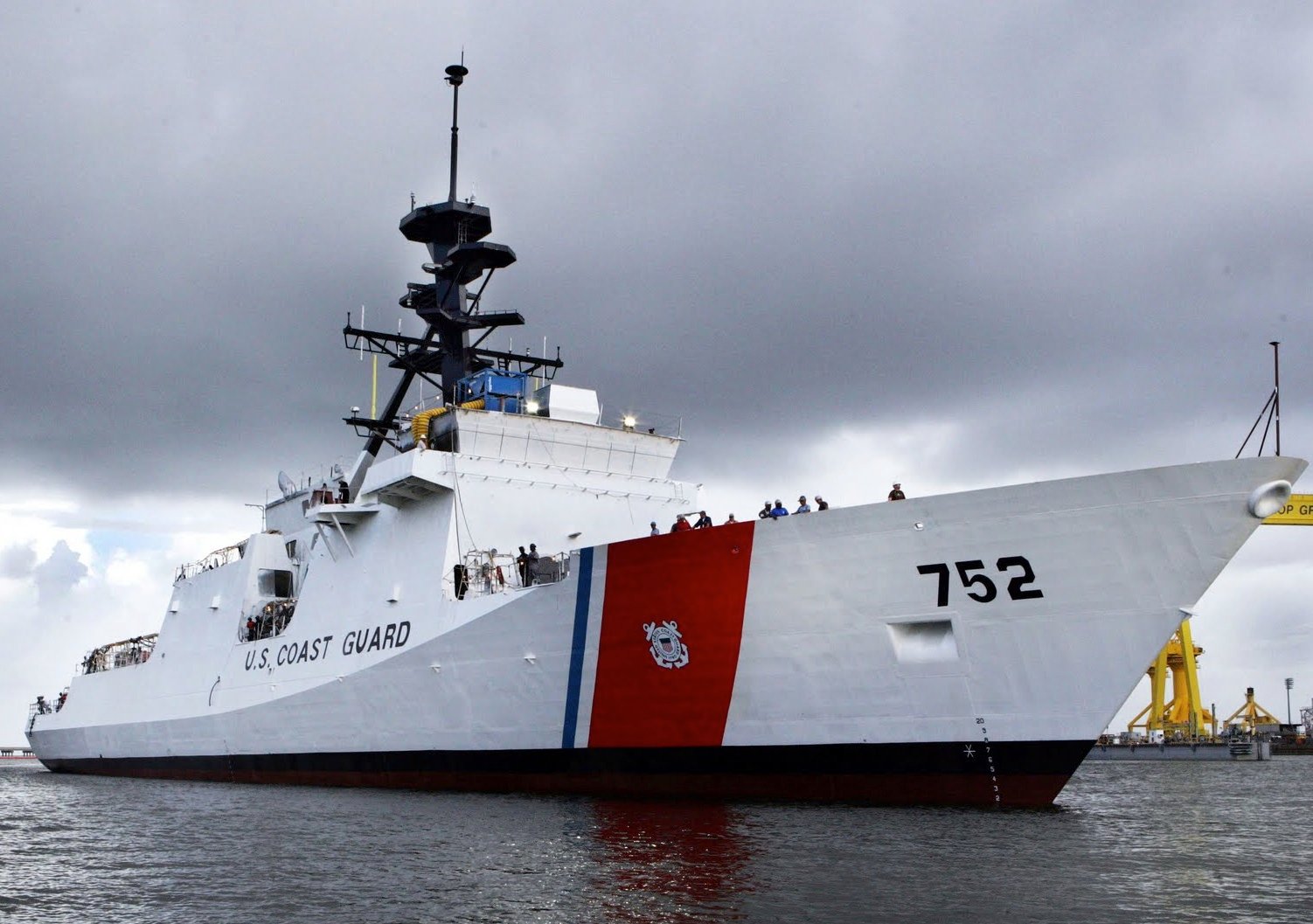
The ability of this resource to oversee an operation and make interdictions far from shore is particularly important during a time when the Navy is increasing its resources in the Asia-Pacific region.
In April of 2014, Secretary of Defense Chuck Hagel announced that the Navy would commit to sending two additional ballistic-missile defense destroyers to enhance the United States’ ability to defend Japan by 2017—part of increasing America’s high-profile presence in the Asia-Pacific region. Adm. Jonathan Greenert, Chief of Naval Operations, noted in an article he authored for Foreign Policy, the Navy “will increase the day-to-day naval presence in the Asia-Pacific region by about 20 percent, to 60 ships by 2020.”
He said, “The Asia-Pacific will become increasingly important to our national prosperity and security.” Underscoring the Navy’s commitment to this region, in March 2014, the USS Freedom, a littoral combat ship, conducted her maiden overseas deployment to Southeast Asia.
Marine Gen. John F. Kelly, Commander United States Southern Command said Coast Guard’s national security cutters serve as a critical force countering transnational organized crime when fiscal constraints limit the availability of large surface assets such as U.S. Navy frigates.
“To mitigate shortfalls, we rely heavily on the U.S. Coast Guard and Customs and Border Protection, which now provide the bulk of ships and aircraft available to disrupt drugs bound for the United States,” Kelly told the House Armed Services Committee in February. “Severe budget constraints are significantly degrading our ability to defend the southern approaches to the United States.”
There is a significant need for more resources to limit trafficking. “The requirement for ships is much greater than the resources available,” said Col. Greg Julian, U.S. Southern Command’s public affairs officer. “Through our detection and monitoring we see 80 percent and can only interdict 20 percent.”
Illicit drugs coming to the United States from South America pass through an area known as the Transit Zone, roughly 7 million square-miles, about twice the size of the continental United States. This zone includes the Gulf of Mexico and Caribbean Sea, the Eastern Pacific Ocean near Mexico and waters adjacent to Central and South America. United States Southern Command, located near Miami in Doral, Florida, is responsible for contingency planning and operations in this area and for defense the of the Panama Canal. One of its components, the Joint Interagency Task Force – South, monitors activity in the Transit Zone.
According to Jose Ruiz, a U.S. Southern Command spokesperson, 86 percent of the drugs that come into the United States move through the Caribbean and Pacific waters near Central America’s isthmus.
“It’s very likely if drugs [cocaine] were seized off the coast of Mexico, they may have transited through SOUTHCOM’s area of responsibility.” He says the source for cocaine trafficked around world is the Andean region of Colombia, Peru and Bolivia. Marijuana is sourced from many locations.
The introduction of the Coast Guard’s flagship into this maritime battlefield is timely. The ship’s enhanced communications suite, combination of 12,000-mile range and 60- to 90-day crew stamina as well as the ability to operate in extreme weather increase the Coast Guard’s influence and availability. This agility and means to operate at higher sustained transit speeds, greater distances away from American shores also provide a unique form of diplomacy to persuade as a “soft power” in geographic areas where our nation may not want to leverage the hard power of a U.S. Navy warship to coerce. This was evident in the 2008 deployment of a Coast Guard cutter off the Republic of Georgia as tensions escalated with Russia.
The cutter’s speed, robust C4ISR (command, control, communication, computers, intelligence, surveillance and reconnaissance) equipment and access to similar international combat ships are powerful instruments for international partnerships, defense readiness and border security.
Complemented by fast small boats and helicopters launched from her decks, this resource is a key to the unified efforts of domestic and international partners to safeguard our homeland, confront threats from transnational organized crime networks, prevent drug and human smuggling and save lives far offshore, according to Chief Warrant Officer Chad Saylor, a Coast Guard spokesperson. These ships also patrol the North Pacific enforcing fisheries laws, simultaneously providing critical search and rescue coverage in the harsh Bering Sea.
Capt. John McKinley, former commanding officer of the Waesche, recently led the super cutter through an international military exercise—Rim of the Pacific. McKinley said the cutter’s capabilities are the “linchpin for being able to operate and make decisions.” He demonstrated this while aboard Waesche and commanding a task force of ships from the People’s Republic of China, Brunei, Mexico, France and New Zealand to help foster cooperative relationships. “This is very cool stuff.” Of the many cutters he’s served on in the Coast Guard, McKinley said, “this is the most capable ship.”
Capt. Andy Tiongson, the prospective commanding officer of the Coast Guard Cutter James, the fifth national security cutter, said that the austere fiscal environment, coupled with the U.S. Navy’s rebalance of forces to the Pacific, could result in “somewhat of a void” of fewer military ships and assets closer to home.
“Who’s home here, in our backyard?” Tiongson asked. “The answer is going to be the United States Coast Guard. We have always operated here and with the recent release of our Western Hemisphere Strategy, we will continue emphasis in this region.”
The Chase
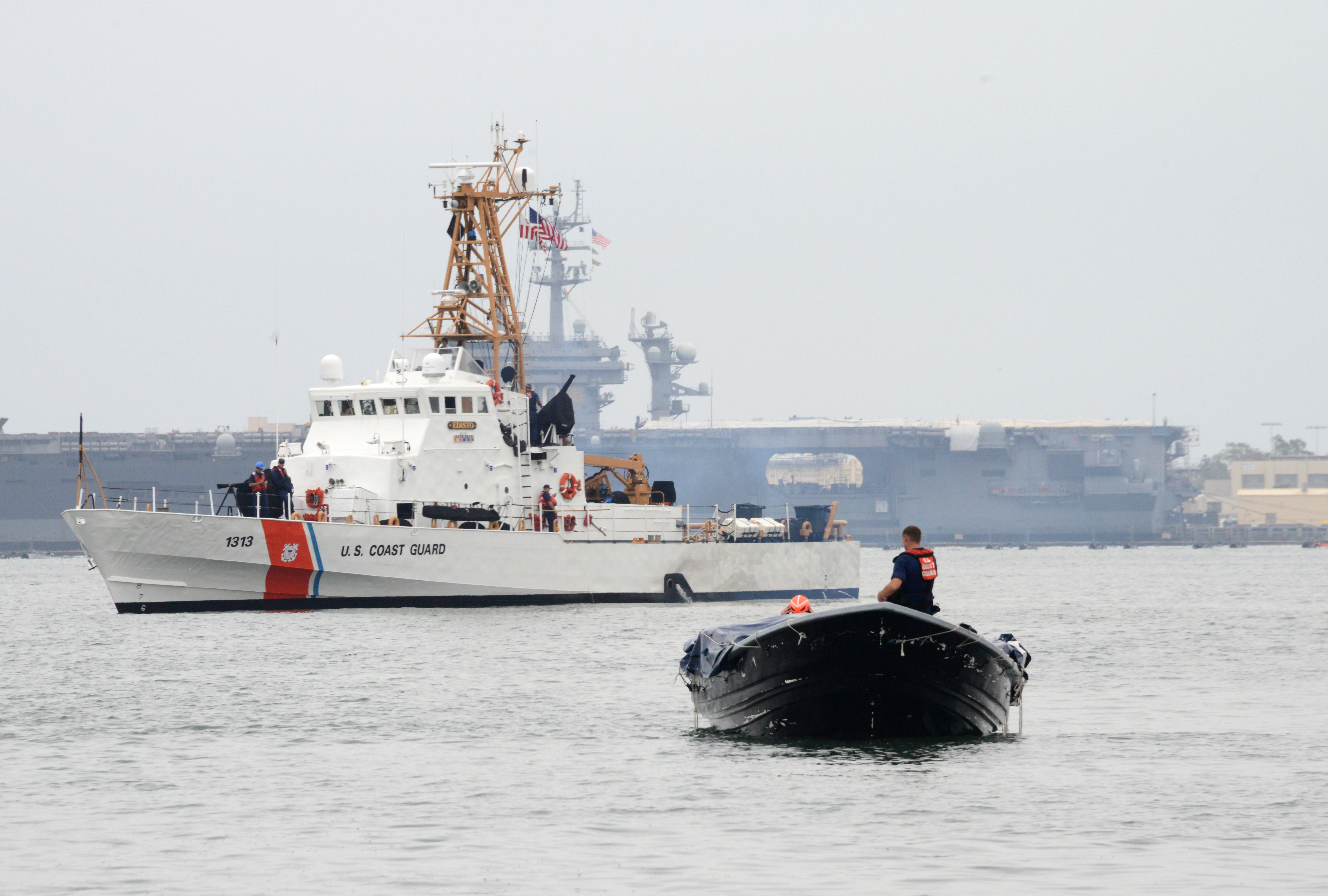
Sugimoto has an arsenal to catch the smugglers. His team planned to use the C-130 fixed-wing aircraft on scene from Air Station Sacramento and two of the cutter’s high-speed small boats designed to operate 40 miles away. At their disposal was the cutter’s stern boat launch, a flight deck and two helicopter hangers that could support MH-65D or HH-60T helicopters or in the future, an unmanned aircraft system.
The aircraft covertly circled above the suspects, tracking and videotaping their movements as the armada approached. Stratton’s two small boats flanked the Petrel. From about two miles away, Petrel’s crew, from its higher vantage point above the water, witnessed two suspects scrambling from the larger boat into the smallest craft, known as a panga or “go-fast.” The four men took off, leaving behind the larger panga, a deep-hulled wooden vessel with four 225-horsepower engines and an unknown cargo hidden under tarps.
The Coast Guard had planned for such a trick. According to Chief Brian Milcetich, 42, a boarding officer riding in one of the two cutter small boats, his team proceeded as planned to the panga they suspected contained the drugs, the bigger one. Milcetich was also the pursuit mission commander, the person responsible for overseeing the law enforcement procedures they would use to stop the escapees.
“Pretty scary,” Milcetich said when they arrived to board the vessel. “It was covered in tarps. We didn’t know if someone was going to jump out.” The boarding team conducted a quick sweep of the vessel. As they pulled back the tarp, he gasped, “’Holy shit.’ This thing was laden with a lot of drugs. I’ve been in over 17 years and I’ve never seen that much.” They waited about 20 minutes for Stratton to relieve them of their duties making sure the go-fast would not sink with the contraband. They turned to chase.
Petrel and the second Coast Guard small boat had kept a respectable distance behind the fleeing vessel, which was speeding at more than 30 knots. They were about 15 miles away from Milcetich. “It was brutal to be a passenger on a small boat in 4-foot seas getting tossed around for two hours,” said Milcetich of the pounding ride at 40 knots. When Milcetich’s boat caught up, it was late afternoon. The sky was slightly overcast. The sun peeked though the clouds. They had little time before sunset.
U.S. Southern Command coordinates enforcement operations to deny transnational criminal organizations use of our backyard’s Transit Zone air and maritime routes. Southern Command’s component command, Joint Interagency Task Force-South, monitors suspect activity and hands off leads to the U.S. Coast Guard and partner agencies for investigation.
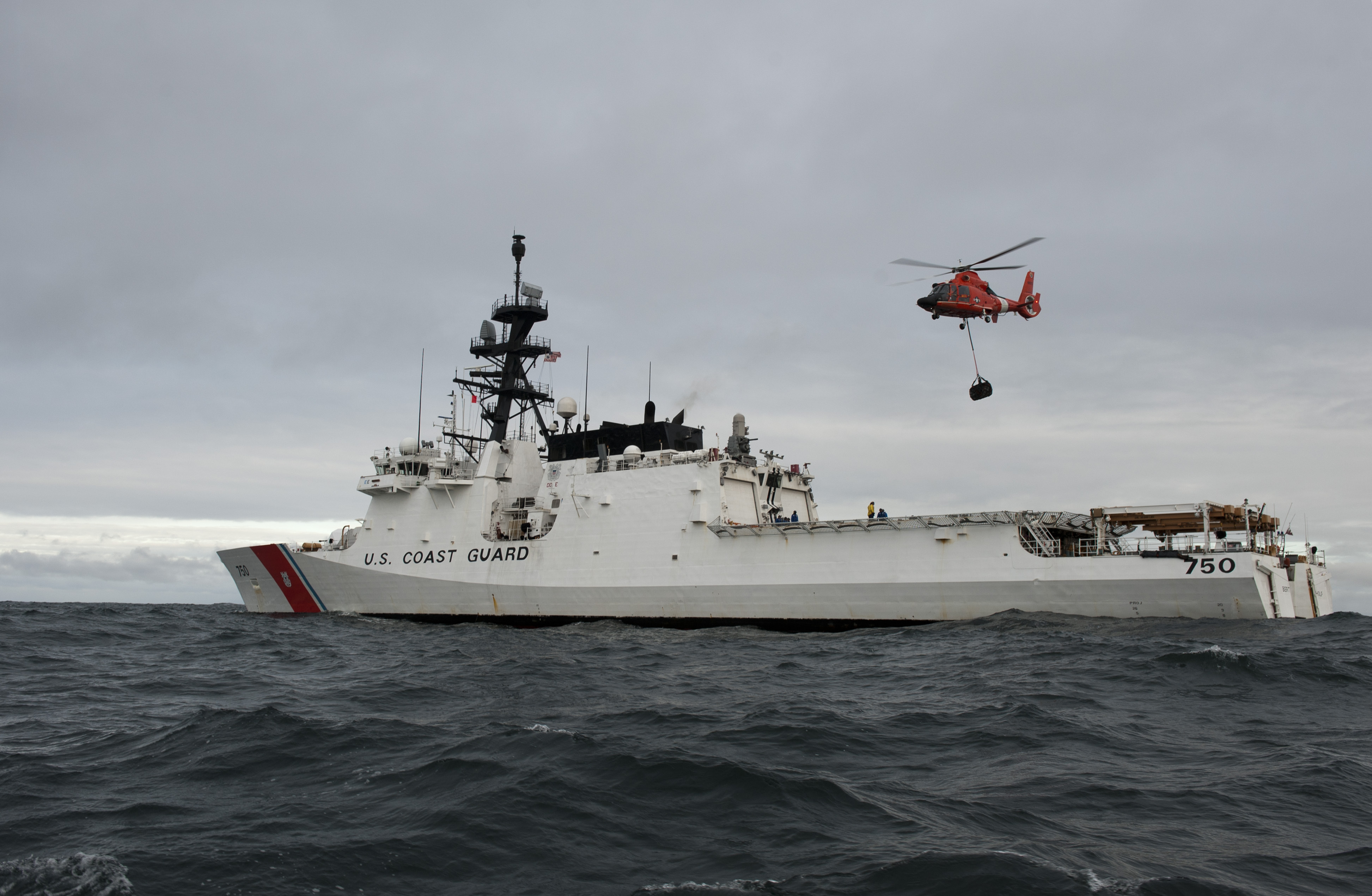 According to the Coast Guard, during a five-month period between February and July of 2014 the Bertholf, Waesche and Stratton made 13 drug busts resulting in the seizure of more than 7,600 kg of cocaine and 28,000 pounds of marijuana worth an estimated $280 million.
According to the Coast Guard, during a five-month period between February and July of 2014 the Bertholf, Waesche and Stratton made 13 drug busts resulting in the seizure of more than 7,600 kg of cocaine and 28,000 pounds of marijuana worth an estimated $280 million.
The success of the three operating cutters confronting transnational organized criminal operations is not lost on U.S. Southern Command. Jose Ruiz, a command spokesperson, said that recently Bertholf completed a three-month deployment in the Eastern Pacific, which includes the western boundary of Southern Command’s oversight. During that time the cutter had six successful apprehensions resulting in over seven metric tons of cocaine seized and 17 arrests. “We rely on the Coast Guard everyday,” he said.
Over the past five years, according to Coast Guard statistics, Coast Guard cutters, Allied ships and U.S. Navy ships with Coast Guard boarding teams, in the transit zone, removed more than 500 metric tons of cocaine—a wholesale value of nearly $17 billion. According to the Coast Guard, “this is approximately three times the amount of cocaine, at twice the purity, seized by all other U.S. federal, state and local and tribal law enforcement agencies combined over the same time span.”
During the August christening of a new National Security Cutter, James in the Pascagoula, Miss. shipyard, the service’s vice commandant acknowledged this kind of ship’s increased impact on the drug war.
“We’ve already seen more per patrol in terms of drugs interdicted, illegal smugglers and illegal activity in our fishing zones,” Vice Adm. Peter Neffenger said.
“We’ve already seen them catch more of those than any of their predecessors had ever done before.” Neffenger said James, as demonstrated by the success of the her sister ships, will “provide a big line of defense against those who would bring illegal goods into our country, who would smuggle people, smuggle drugs, and take advantage of our resources.”
The Capture
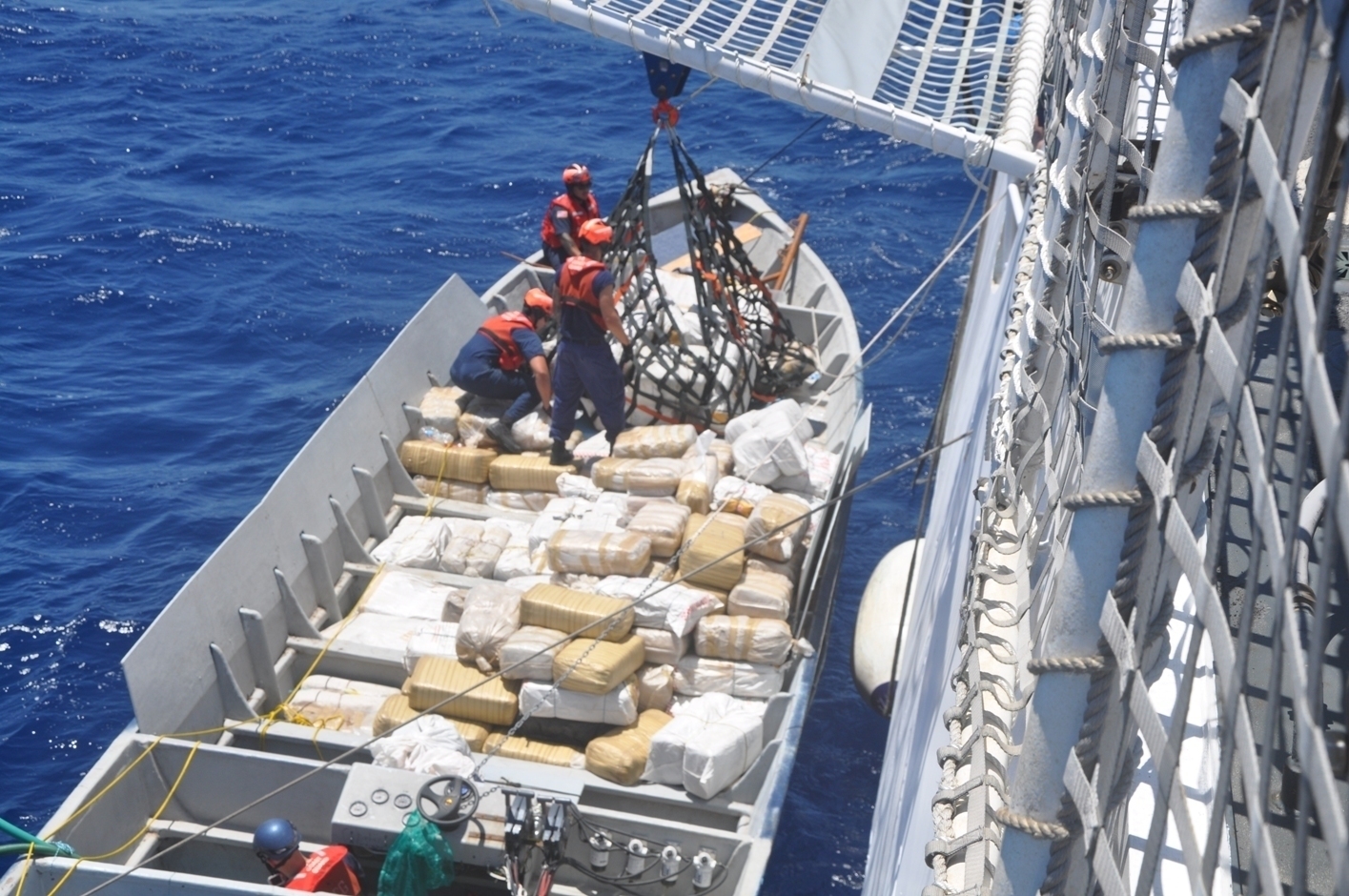
The smugglers tried diverting the law enforcement teams, tossing bundles overboard. The small boats had no problem circling around and retrieving the items before catching up again.
The hunters and their prey moved out of eyesight of the Stratton’s bridge watch but not out of view of the ship’s sensors. For about 20 minutes, Milcetich’s team gave the four men every chance to stop on their own. He commanded in Spanish over the loud hailer, “Stop your vessel.” His law enforcement team used hand signals and flashed blue lights to get their attention. “They were having none of it,” he said. The fleeing men drove the boat erratically, used trick maneuvers like the corkscrew, circling then reversing direction quickly attempting to lose the Coast Guard.
The Coast Guard’s pursuit gunner on the lead small boat prepared his weapon. He fired warning shots, releasing rounds of loud pops and flashes of light. “They couldn’t care less,” said Milcetich who radioed the situation to Stratton. Capt. Sugimoto authorized use of physical force to compel the smugglers to stop.
The seas were getting larger, nearly six feet, and the day’s light was fading. Milcetich prepared to close and have his gunner shoot out the engine. He was concerned in this sea state that a slight bump of the marksman would cause his aim to be off. He confided with his four teammates about the risks vs. gain. He asked the gunner, Are you sure you can do this?” The gunner was confident, asking the coxswain to get him in closer. Milcetich’s final question was, “Are you all sure this is a perfect situation to end this pursuit and everyone be safe?” They all nodded and said “yes”.
As the gunner prepared to take a shot at the boat’s engine, the suspects suddenly turned their vessel, positioning themselves perfectly for the Coast Guard’s alternate plan. The Coast Guard coxswain took the opportunity to drive his boat’s bow into the beam of the panga, forcing a collision. “The men all fell over in the boat,” said Milcetich. “The two guys in front immediately raised their hands—gave up. The two in the back were trying to restart the engine. It died when the kill switch was pulled as they fell.” Milcetich leaped aboard the panga. His team followed. “I went for the guys at the back shouting ‘Hands up’ in Spanish,” he said. They ignored him. One reached for the vessel’s throttle trying to restart the engine. “I grabbed his hands. He resisted me and pulled back. To me that’s a threatening response. I ended that.” Milcetich pinned the suspect. The fourth man put his hands behind his back, giving up. Within seconds all four men were in handcuffs. The sun sank over the horizon.
“Pretty cool example of using all the different capabilities of the ship exercised by an outstanding crew,” Sugimoto said. “We were able to maintain control and take it down.”
According to the plea agreement filed in September in the United States District Court Southern District of Calif. approximately 5,305 kilograms (11,695 pounds) of marijuana were seized 115 nautical miles southwest of Ensenada, Mexico. One of the men plead guilty, admitting he and three others helped transport the marijuana to the United States for distribution.
Milcetich agrees the national security cutter’s capabilities are impressive. For him, what makes the ship successful he says is the crew. “For us to take our hats off from a training exercise and shift suddenly into this law enforcement mode—it’s more a testament to the people we have on board than the capabilities of the NSC,” he said.
Lt. Cmdr. Holden agreed. “Getting to work with the exceptional people on board is the only reason I keep asking to go back to sea.”





